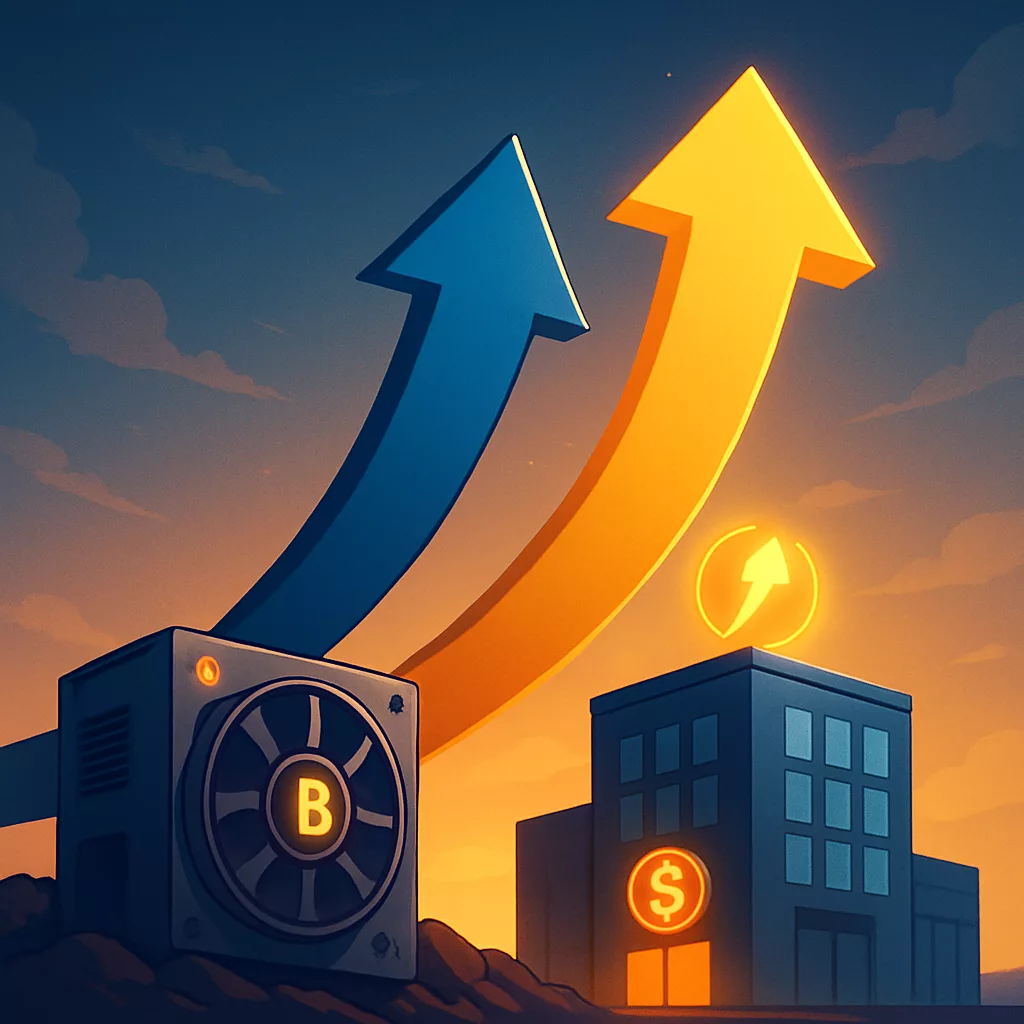Contenidos
- Visión general de la red
- Norteamérica, Eurasia y Latinoamérica dominan la distribución de hashrate de Bitcoin
- Los Mempools privados plantean riesgos de centralización para Bitcoin
- Aumentan los ingresos de los mineros de Bitcoin y las entradas de divisas, pero el mercado tiene margen de crecimiento
- VanEck propone regalías a los mineros para crear una reserva estratégica de Bitcoin en EE.UU.
- Bitmain lanza Antminer S23 Hydro, el equipo de minería más eficiente del mercado
Visión general de la red
Otra semana, otra cuesta arriba para los mineros. La dificultad de red de Bitcoin aumentará en casi 4% mañana, uno de los mayores incrementos desde la reducción a la mitad. El ajuste refleja el renovado interés de los mineros impulsado por la reciente fortaleza de los precios, pero también indica la intensificación de la competencia mundial. Para los operadores de alta eficiencia, es una oportunidad de consolidar su liderazgo. Para otros, puede marcar el principio del fin.
Aunque la dificultad se ha mantenido estable hasta ahora, la caída del precio del BTC ha hecho bajar los ingresos de los mineros. Las comisiones por transacción siguen siendo respetables, pero no compensan la diferencia. El mempool creció ligeramente, lo que apunta a una demanda constante de espacio de bloque, pero con un valor de transacción más bajo, esa demanda puede ser más ruido que señal. De un modo u otro, la semana que viene se presenta como una prueba de resistencia para gran parte del sector minero.

Norteamérica, Eurasia y Latinoamérica dominan la distribución de hashrate de Bitcoin
El mapa de calor de minería de Bitcoin del segundo trimestre de 2025 de HashrateIndex muestra que Estados Unidos sigue siendo el líder mundial en hashrate de Bitcoin, con 36,03% de la red. Rusia está ganando terreno de manera constante con 15,65%, mientras que China, a pesar de las prohibiciones y medidas enérgicas, todavía mantiene 13,73%. Es probable que China lo consiga mediante operaciones a menor escala o no oficiales en provincias ricas en energía hidroeléctrica como Sichuan y Xinjiang. Canadá posee 2,92%, reforzada por el acceso a las energías renovables en regiones como Quebec y Columbia Británica.

Otras regiones mineras activas son Paraguay (3,60%), Kazajstán (2,48%), EAU (3,73%), Omán (3,11%) e Irán (1,24%). La presa paraguaya de Itaipú sigue llamando la atención por su abundante energía hidroeléctrica, mientras que países como Irán y Kazajstán han utilizado la minería para monetizar el excedente de energía o eludir sanciones económicas. En cambio, grandes zonas de África, el Sudeste Asiático y Oriente Medio permanecen en su mayoría inactivas debido a los elevados costes de la electricidad, la debilidad de las infraestructuras o las barreras políticas.
En general, el panorama minero mundial sigue estando determinado por la economía de la energía y el clima normativo, con Norteamérica, Eurasia y algunos países latinoamericanos firmemente establecidos como los puntos calientes actuales de la minería de Bitcoin.
Fuente: noticias.bitcoin.com
Los Mempools privados plantean riesgos de centralización para Bitcoin
Mientras que el mempool público alinea los incentivos entre usuarios y mineros, las API privadas y los mecanismos de envío fuera de la cadena (como Slipstream de Marathon) crean flujos de transacciones opacos. Estos sistemas permiten a los mineros aceptar transacciones que no se propagan a través de los canales de retransmisión estándar, evitando la censura o los retrasos, pero a costa de la transparencia y la descentralización.

A medida que más mineros adoptan API privadas o soluciones de terceros como mempool.space, el mercado de comisiones puede distorsionarse, y los mineros más pequeños se enfrentan a una desventaja debido a los gastos generales y el reparto de ingresos. Los sistemas de segunda capa como Lightning también podrían verse comprometidos, ya que los mempools privados dificultan a los usuarios el control de las transacciones sensibles al tiempo. El aumento de redes de mempools fragmentadas o paralelas introduce complejidad y fricción en la experiencia de usuario, lo que en última instancia refuerza la centralización al favorecer a los grandes mineros con acceso directo al flujo de órdenes privadas.
Fuente: bitcoinmagazine.com
Aumentan los ingresos de los mineros de Bitcoin y las entradas de divisas, pero el mercado tiene margen de crecimiento
Los ingresos de los mineros de Bitcoin han subido a $51,6 millones al día, señal de una red sana y activa, aunque todavía por debajo del máximo del ciclo anterior de más de $80 millones. Esto podría anunciar un potencial alcista continuado para los mineros si el mercado alcista se consolida. Las entradas de mineros en las bolsas también se han duplicado recientemente, de 25 BTC a 50 BTC al día, tras los recientes máximos históricos de Bitcoin.

A pesar del aumento de las ventas de los mineros, el mercado ha absorbido la oferta añadida sin mayores trastornos. Estas tendencias sugieren que Bitcoin sigue en fase de crecimiento, sin haber llegado aún al agotamiento del ciclo. Los analistas estiman que el próximo máximo podría situarse entre $200.000 y $250.000, con la posibilidad de alcanzar cotas más altas si crece la demanda institucional en respuesta a la inestabilidad económica.
Fuente: coinedition.com
VanEck propone regalías a los mineros para crear una reserva estratégica de Bitcoin en EE.UU.
El jefe de investigación de activos digitales de VanEck, Matthew Sigel, ha propuesto un sistema de regalías para que los mineros de Bitcoin de EE.UU. financien una reserva federal de Bitcoin sin el gasto de los contribuyentes. En su intervención en la Conferencia Bitcoin 2025, Sigel sugirió que los mineros contribuyan con una pequeña parte de sus recompensas en bloque al Tesoro, lo que podría ser ordenado a través de la conciliación presupuestaria o incluido en proyectos de ley. Este enfoque sería neutro desde el punto de vista presupuestario y seguiría el modelo de los royalties federales procedentes de la extracción de petróleo y gas.

Sigel también abogó por eximir de impuestos a los mineros que utilizaran metano residual, vinculando los beneficios medioambientales con la acumulación de BTC. Estos mineros podrían operar plataformas móviles en sitios de gas quemado, ganar recompensas libres de impuestos y enviar una parte de regalías a la reserva. El plan se alinea con la orden ejecutiva de Trump de marzo para construir una Reserva Estratégica de Bitcoin y podría ayudar a los EE. UU. a "apilar sats" al tiempo que reduce las emisiones y fortalece la resiliencia financiera nacional.
Fuente: cryptoslate.com
Bitmain lanza Antminer S23 Hydro, el equipo de minería más eficiente del mercado
Bitmain ha presentado el Antminer S23 Hydro, un nuevo equipo de minería que proporciona 580 TH/s con un consumo de 5.510 vatios, alcanzando una eficiencia líder en el mercado de 9,5 J/TH. Anunciado en la Cumbre Mundial de Minería Digital 2025, el lanzamiento se produce en medio de la disminución de la demanda de hardware de minería tras la reducción a la mitad de Bitcoin en 2024, que redujo a la mitad las recompensas por bloque a 3,125 BTC. El S23 Hydro está diseñado para ayudar a los mineros a seguir siendo competitivos mediante la reducción de los costes operativos.

Bitmain también se está adaptando a las condiciones del mercado ofreciendo condiciones de pago flexibles, como planes de pago a plazos y reservas respaldadas por bitcoins. Los compradores de ASIC disfrutan ahora de mayor influencia, con empresas como CleanSpark y HIVE negociando acuerdos favorables. Los primeros envíos del S23 Hydro están previstos para el primer trimestre de 2026, y los primeros compradores recibirán descuentos. A medida que se reducen los márgenes de la minería, la eficiencia y los costes energéticos se han convertido en factores críticos para la supervivencia.
Fuente: noticias.bitcoin.com